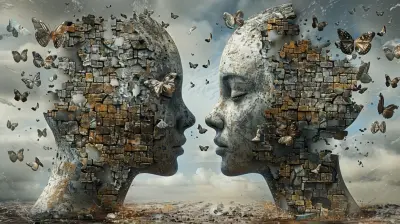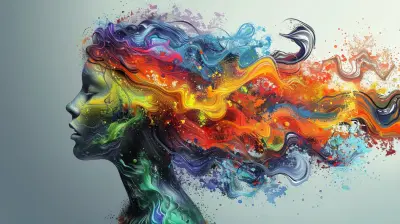The Science Behind Why Psychotherapy Works
2 August 2025
Psychotherapy has been around for decades, yet many people still wonder how it actually helps. Does sitting down and talking to someone about your problems really make a difference? The short answer—yes, but there’s more to it than just talking.
Psychotherapy is deeply rooted in science, involving mental, emotional, and behavioral processes that promote healing and self-awareness. Whether it’s Cognitive Behavioral Therapy (CBT), Psychodynamic Therapy, or Humanistic Therapy, all forms of psychotherapy share a common goal: improving emotional well-being and helping people develop healthier patterns of thinking and behaving.
In this article, we’ll break down the psychological and neurological mechanisms that explain why psychotherapy works.

How Psychotherapy Influences the Brain
Psychotherapy is not just about venting your problems—it rewires your brain. Neuroscience has shown that psychotherapy changes neural pathways, promoting healthier cognitive patterns and emotional responses.Neuroplasticity: Rewiring the Brain for Better Mental Health
The brain isn’t static. It’s malleable and constantly changing based on experiences, thoughts, and behaviors. This ability to restructure itself, known as neuroplasticity, plays a crucial role in the effectiveness of psychotherapy.When you engage in therapy, your brain forms new neural connections that strengthen over time. For example, if you struggle with anxiety, therapy helps create alternative pathways that reduce anxious responses and promote calmness. Repeatedly practicing new thought patterns eventually makes them automatic, reducing negative thinking and emotional distress.
The Role of the Prefrontal Cortex and Amygdala
The brain’s prefrontal cortex (responsible for rational thinking and decision-making) and the amygdala (which processes emotions like fear and stress) play a fundamental role in mental health.- In conditions like anxiety and PTSD, an overactive amygdala heightens fear responses.
- Psychotherapy, particularly Cognitive Behavioral Therapy (CBT), strengthens the prefrontal cortex’s ability to regulate emotional reactions from the amygdala.
- Over time, patients become more resilient, reducing their tendency to react impulsively or emotionally to stressors.
Chemical Changes in the Brain
Another fascinating aspect of psychotherapy is how it influences neurotransmitters—chemical messengers in the brain.- Serotonin (linked to mood regulation) increases with effective therapy, improving feelings of happiness and reducing depression.
- Dopamine (the "reward" neurotransmitter) boosts motivation and a sense of accomplishment.
- Cortisol (the stress hormone) decreases with therapy, reducing chronic stress responses.
In essence, therapy helps rebalance brain chemistry, improving overall emotional well-being.

The Psychological Mechanisms Behind Psychotherapy
Beyond brain chemistry, psychotherapy taps into psychological principles that help people understand themselves better and change their thinking patterns.Cognitive Restructuring: Shifting Thought Patterns
A big part of therapy is challenging negative thought patterns and replacing them with more constructive ones. This process, known as cognitive restructuring, is the backbone of many evidence-based therapies like CBT.For example, someone struggling with depression might frequently think, "I'm a failure." Therapy helps them identify and challenge this thought, replacing it with something more balanced like, "I’ve had setbacks, but that doesn’t define my entire worth." Over time, these shifts can dramatically improve self-esteem and emotional resilience.
Behavioral Activation: Changing Habits for the Better
Sometimes, people get stuck in negative cycles of behavior. For instance, depression often leads to social withdrawal, which in turn worsens feelings of loneliness and sadness.Therapists encourage behavioral activation, which means identifying and engaging in activities that promote positive emotions. This technique helps break the cycle of avoidance and reintroduces pleasure and purpose into daily life.
The Power of Emotional Processing
Suppressing emotions can be harmful—bottling up feelings can lead to anxiety, stress, and even physical illness. Psychotherapy provides a safe space to process emotions in a healthy way.By talking about painful experiences, people learn how to regulate their emotions rather than being overwhelmed by them. This emotional “release” is crucial for healing, particularly in trauma-focused therapies.

The Therapeutic Relationship: Why Connection Matters
One of the most crucial elements of psychotherapy isn’t just the technique being used—it’s the relationship between the therapist and the client.The Importance of Trust and Safety
Therapists create a non-judgmental and supportive environment where clients feel safe to express their thoughts and emotions. This trust fosters vulnerability, which is essential for personal growth and healing.Think of a therapist like a guide on a challenging hike—you still have to walk the path, but having someone to support and guide you makes the journey easier.
Mirror Neurons: The Science of Feeling Understood
Studies suggest that human brains contain mirror neurons, which play a role in empathy and social bonding. When we feel understood and validated by another person, it activates these neurons, reinforcing a sense of connection and support.This explains why talking to an empathetic therapist can feel deeply comforting—it literally activates neurological pathways that promote calmness and security.

Long-Term Benefits of Psychotherapy
Psychotherapy doesn’t just help in the short term; its benefits extend far beyond the time spent in sessions.Improved Emotional Intelligence
Therapy teaches people how to recognize and regulate their emotions effectively. Over time, this leads to better relationships, improved decision-making, and greater self-awareness.Greater Resilience to Stress
By learning new coping mechanisms and thought strategies, therapy helps individuals handle stress more effectively. Instead of being overwhelmed by life’s challenges, they learn how to navigate difficulties with increased confidence and emotional stability.Breaking Generational Trauma
Many psychological struggles are passed down through generations—such as unhealthy communication patterns, anxiety, or low self-esteem. Therapy helps break these cycles by fostering healthier ways of thinking and behaving, ultimately improving not only the individual’s life but also future generations.The Bottom Line
At its core, psychotherapy works because it taps into both the brain’s ability to change and the power of human connection.- It rewires the brain through neuroplasticity, enhancing emotional regulation.
- It challenges and reshapes negative thoughts into healthier beliefs.
- It provides a safe space where people can process emotions and develop resilience.
- It equips individuals with lifelong coping strategies, improving mental health and well-being.
So, the next time someone questions whether therapy works, the answer is a resounding yes—and it’s backed by science.
all images in this post were generated using AI tools
Category:
PsychotherapyAuthor:

Janet Conrad
Discussion
rate this article
1 comments
Kenneth Gibson
This article beautifully captures the essence of psychotherapy. Understanding the science behind it provides hope and validation for those seeking help. It's a reminder of the profound healing that can occur through connection and insight. Thank you!
August 20, 2025 at 4:45 AM

Janet Conrad
Thank you for your thoughtful feedback! I'm glad the article resonated with you and highlighted the healing power of psychotherapy.


